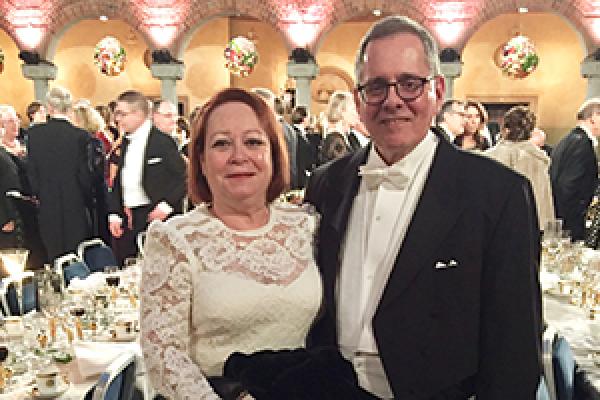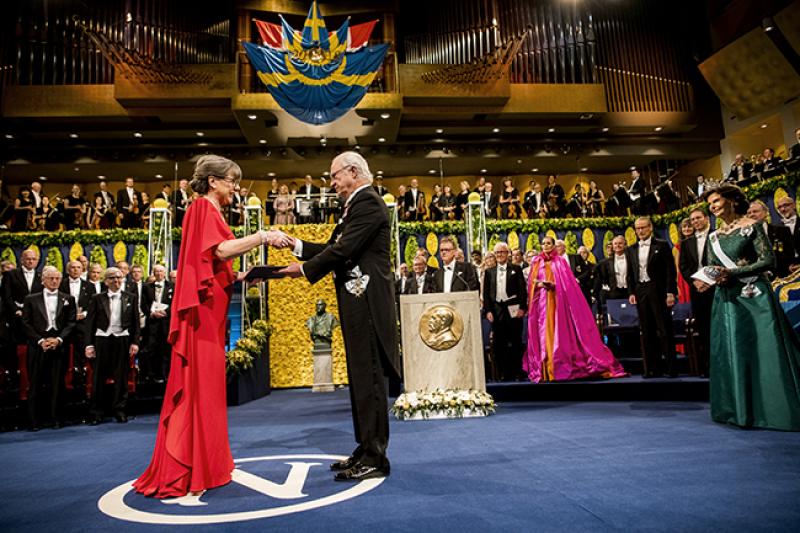Physics professor lights up 2018 Nobel Prize ceremony

While most of us were gearing up for a much-needed and well-deserved winter break, physics professor Louis Franklin DiMauro was en route to Stockholm, Sweden, to attend the 2018 Nobel Prize award ceremonies.
The Nobel Committee for Physics and Royal Swedish Academy of Sciences invited DiMauro, Edward E. and Sylvia Hagenlocker Chair of Physics, and his wife, Barbara, to attend the exclusive festivities for his expertise in laser physics, which is the same field the 2018 Nobel Prize in Physics was awarded in — to scientists Arthur Ashkin, Gérard Mourou and Donna Strickland.
The multiday celebration — filled with luxurious parties, extravagant entertainment and deluxe cuisine — culminates each year on Dec. 10, when Swedish King Carl XVI Gustaf bestows the Nobel Prizes in physics, chemistry, physiology, medicine and literature upon the newest laureates (the Nobel Peace Prize is awarded separately in Oslo, Norway).
“It was a big surprise to be invited, and I felt really honored because I know it’s a pretty hard invitation to get,” DiMauro said. "It was a once-in-a-lifetime sort of event.”
The ceremonies had special historical significance, as Strickland is only the third woman ever to be awarded the Nobel Prize in Physics and the first in 55 years.

Donna Strickland receives her Nobel Prize medal from the King of Sweden. © Nobel Media AB 2018. Photo: Alexander Mahmoud
In addition to all the radiance, royalty and formal wear, DiMauro got to personally congratulate the laureates and speak with world-renowned scientists that have impacted the majority of his research career.
The 2018 Nobel Prize in Physics laureates were selected for their revolutionary “tools made of light.” Ashkin received half of the prize for the development of “optical tweezers” that use laser beam fingers to grab and move tiny objects like particles, atoms and viruses. Mourou and Strickland split the remaining half for inventing a technique called chirped pulse amplification (CPA), which allows for ultrashort, high-intensity laser pulses.
DiMauro has utilized CPA in his lab for decades to study fundamental physics, and with the approach, co-developed a widely used model that describes intense laser-atom interaction. His work was cited in the scientific case for awarding the Nobel to Mourou and Strickland.
“The CPA concept laid the path for making amplified, short pulses of light with powers that were 10,000-fold higher than previously possible,” explained DiMauro, adding that the technique is now standard for high-intensity lasers, including those used for corrective eye surgery.

© Johan Jarnestad, Royal Swedish Academy of Sciences
Currently, his lab uses CPA to generate extremely fast laser pulses as precise as one attosecond, or 1×10−18 of a second — an unfathomably short time period (for context, an attosecond to a second is what a second is to roughly 13.77 billion years — the age of the universe).
“Electrons, because they’re light, move very fast,” DiMauro said. “We use these attosecond light pulses to study how electrons move in molecules, how electrons move in solids, etc. And that would not have been possible without the invention of CPA.”
Along with witnessing the awarding of the Nobel Prizes, DiMauro attended the well-known and highly publicized Nobel lectures, concert and the 2018 Nobel Banquet. He also ran into his former student and Ohio State alumnus Jonathan Wheeler (MS, 2009; PhD, 2012), who now lives in France working as a colleague to Mourou.
“Having students like Jonathan here at Ohio State helped us make the impact and advances in our research that we have,” DiMauro said. “The future is bright for this field of research.”
